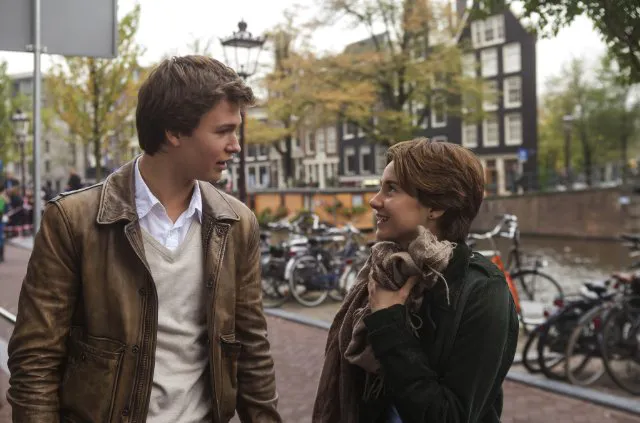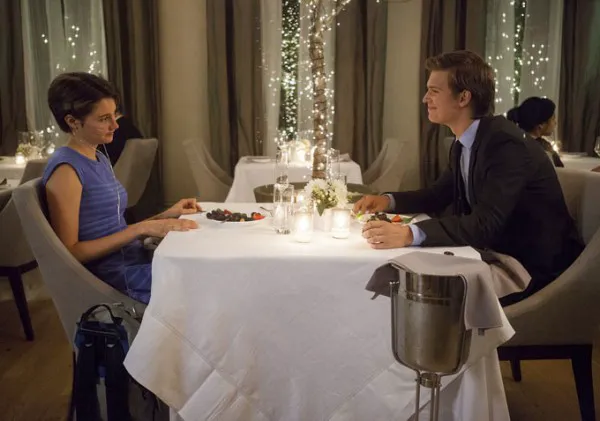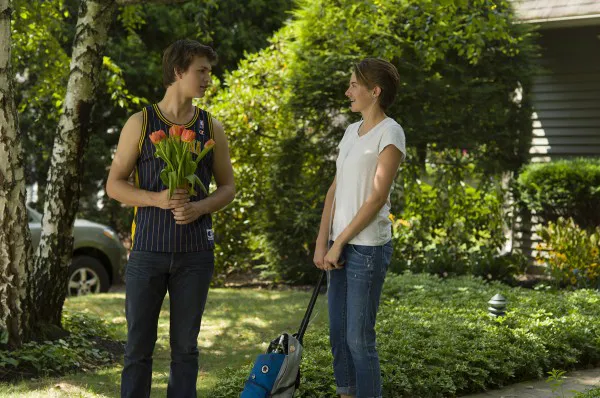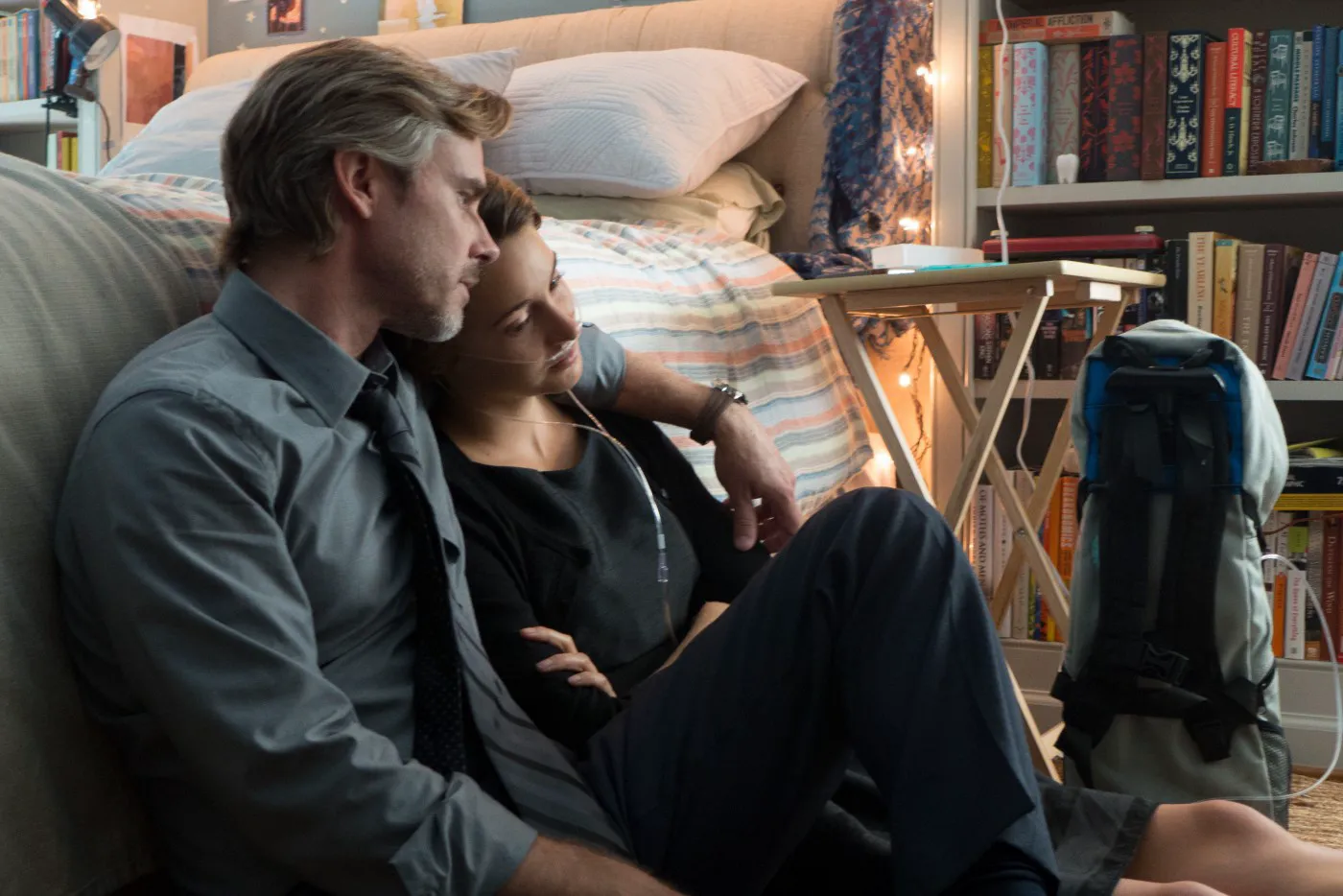An imperfect yet touching, charming, and profound melodrama about dying teenage lovers.
Sixteen-year-old Hazel Grace Lancaster (Shailene Woodley) is slowly dying of lung cancer. The only thing keeping her afloat is an experimental drug that helps her live longer than most patients. At her mother’s insistence, Hazel attends a support group for cancer patients, where she meets 18-year-old Augustus Waters (Ansel Elgort), who lost a leg and his basketball career in his battle with osteosarcoma. The teenagers immediately start flirting with each other, and soon they become best friends and a couple in love.

John Green wrote “The Fault in Our Stars” after being inspired by his acquaintance with video blogger Esther Earl, who lived for four years with an incurable form of cancer. The girl died in 2010 at the age of 16.
A Teen Hit Reflecting Twilight
“The Fault in Our Stars,” a new teen movie hit (the low-budget film has already grossed over $280 million worldwide), is a mirror image of “Twilight.” While Stephanie Meyer’s characters lived forever but seemed emotionally dead, only slightly coming to life during declarations of love, the characters in John Green’s novel adaptation die before the viewers’ eyes (some of them make it to the final credits, but death is only a matter of time for them), yet they appear as embodiments of energy, wit, and enterprise.

Shailene Woodley won the casting for Hazel, in which 150 young actresses participated.
Augustus, for example, could easily win the title of the most romantic protagonist among the heroes of recent “chick flicks.” To hell with the gloomy and mysterious – long live the cheerful and open hero who spends his dying wish (in America, there are charitable foundations that fulfill the wishes of terminally ill children) to go to Amsterdam with his beloved girl and visit her favorite writer (Willem Dafoe)! And how he confesses his love! You just want to print his words and hang them on the wall to make them the slogan of your life. We’ve already seen Elgort in “Divergent,” where he played Woodley’s character’s brother, but as Caleb, the guy was just a pale shadow. In “The Fault in Our Stars,” he sparkles no worse than the “Twilight” vampires, and he does it without special effects.

As usual in such films, Hazel is less dazzling than Augustus, but she also appears as a girl with whom it would be pleasant and interesting to meet at any age. If not for a romance, then for friendship and communication. Well-read, witty, charming, unbending, self-confident, sober-minded, and more concerned about her loved ones than herself, Hazel as a romantic heroine gives a head start to the gloomy Katniss, the pale Bella, and the Tris who looks up to her beloved. She is not spoiled by either the short haircut natural for a cancer patient, or the cannula in her nose and the oxygen tank, without which the girl could not breathe.

A Heartwrenching Love Story
Of all the young couples in love that we have seen in recent years, Hazel and Augustus most deserve joint happiness. The fate of these guys, to whom fate gives only a few months of happiness, is all the more tragic. And the more you want to cry when the picture, which begins as a romantic comedy (albeit with sometimes gallows humor), gradually turns into a drama. You have to be a harsh and cynical critic to refrain from tears at a “Stars” session. Fans of the genre cry their eyes out when they see how bravely the characters hold on in the face of impending separation, how they try to make good use of every day they have left, and what deep, atypical thoughts for teenagers their approach to death leads them to.

Imperfections and Triumphs
Are there any shortcomings in the film? Yes, it is not as dynamic a movie as teenage action blockbusters, and even by the standards of conversational dramas, “The Fault in Our Stars” could be more energetic – especially in the first two-thirds of the narrative. In addition, the storyline associated with Dafoe’s character turned out to be clumsy and, perhaps, superfluous for the picture – as well as for the book (“The Fault in Our Stars” is a close-to-text film adaptation). Surely, one could have come up with a more elegant reason for traveling to Amsterdam or developed the theme of Hazel’s favorite book more interestingly. Finally, the romance of the picture sometimes goes off the charts and reaches vulgarity, and this is definitely not a movie for people with particularly refined artistic taste.
Nevertheless, in its genre, “The Fault in Our Stars” is more than a worthy movie, and those who like such films cannot miss it. If only for the sake of the magnificent Woodley-Elgort couple. They did not impress us too much in “Divergent,” but in the new picture, they are in their place and in the images that they are destined to play.